Measuring Benchmarking Effectiveness in UAE Manufacturing Companies
VerifiedAdded on 2021/04/19
|9
|1221
|58
Report
AI Summary
This report assesses the effectiveness of benchmarking applications within the manufacturing sector, specifically focusing on dairy companies in the United Arab Emirates (UAE). The study utilizes a quantitative research design, employing structured questionnaires administered to ten participating companies. Data analysis was conducted using MS Excel. The findings reveal that benchmarking significantly enhances competitiveness and boosts production output within the manufacturing sector. The report highlights the benefits of benchmarking, including improved production processes and the maintenance of a competitive edge. The research recommends that companies not currently utilizing benchmarking adopt the practice to improve their operations and competitiveness. The report includes a literature review that supports the application of benchmarking and a discussion of the methodology employed, along with ethical considerations.
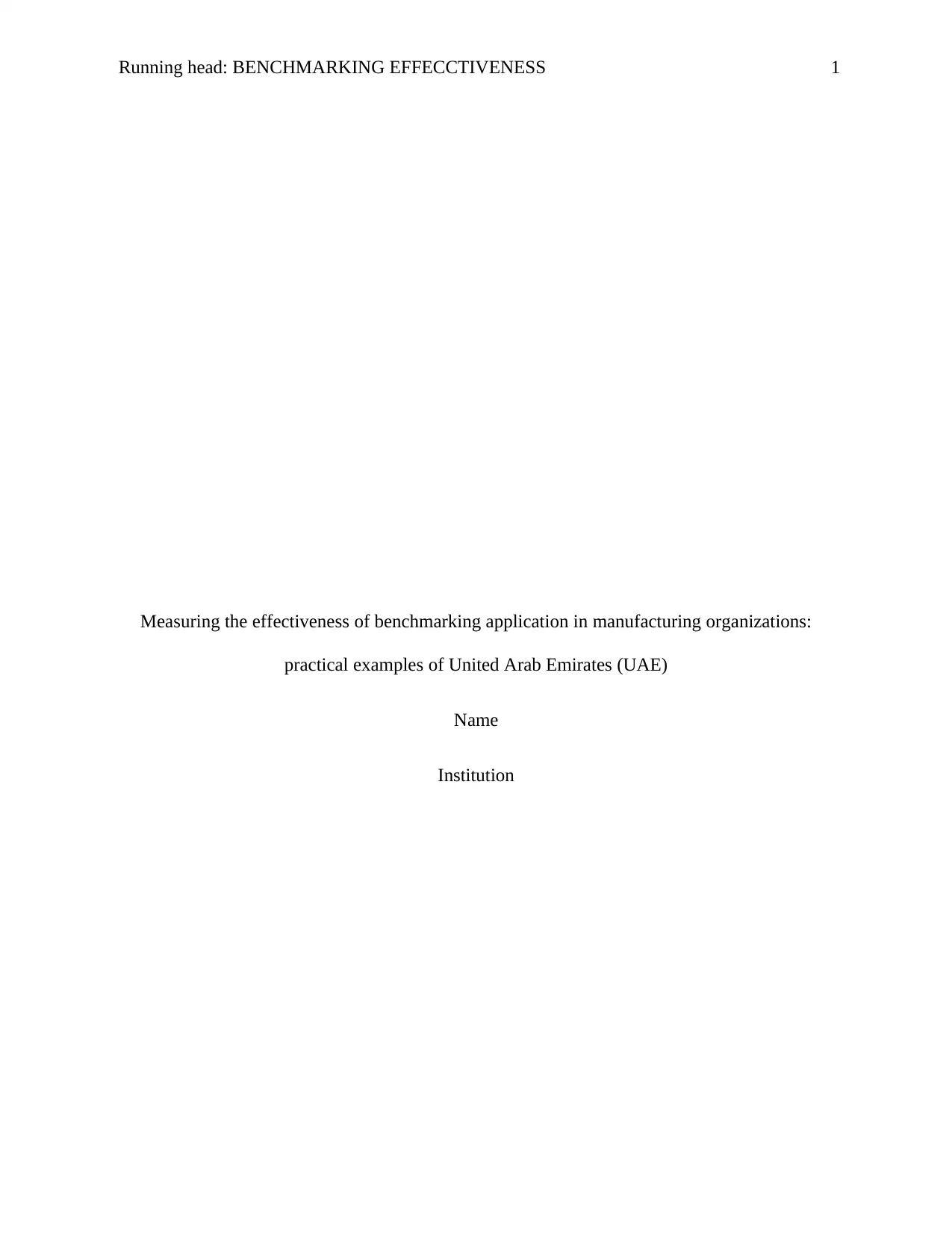
Running head: BENCHMARKING EFFECCTIVENESS 1
Measuring the effectiveness of benchmarking application in manufacturing organizations:
practical examples of United Arab Emirates (UAE)
Name
Institution
Measuring the effectiveness of benchmarking application in manufacturing organizations:
practical examples of United Arab Emirates (UAE)
Name
Institution
Paraphrase This Document
Need a fresh take? Get an instant paraphrase of this document with our AI Paraphraser
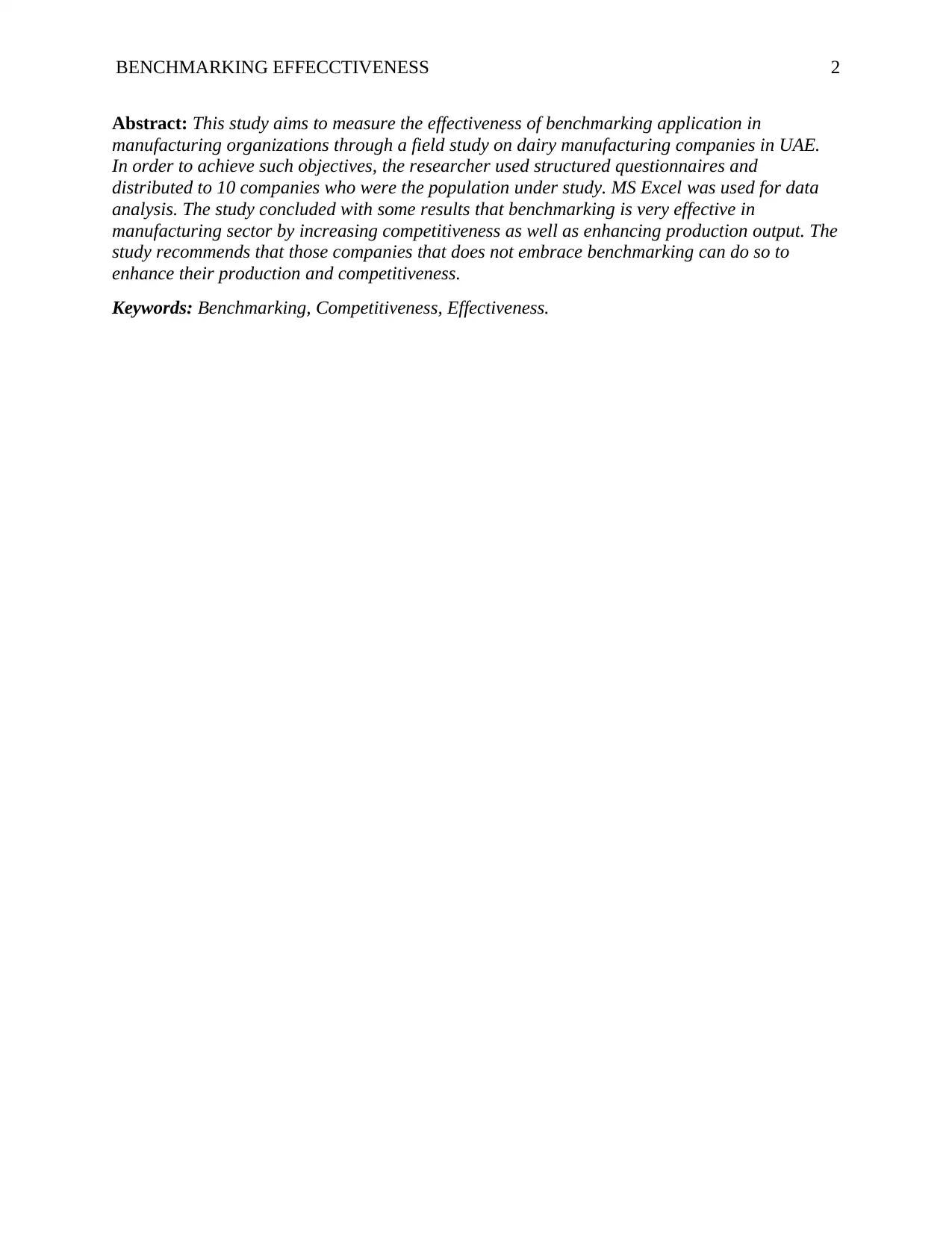
BENCHMARKING EFFECCTIVENESS 2
Abstract: This study aims to measure the effectiveness of benchmarking application in
manufacturing organizations through a field study on dairy manufacturing companies in UAE.
In order to achieve such objectives, the researcher used structured questionnaires and
distributed to 10 companies who were the population under study. MS Excel was used for data
analysis. The study concluded with some results that benchmarking is very effective in
manufacturing sector by increasing competitiveness as well as enhancing production output. The
study recommends that those companies that does not embrace benchmarking can do so to
enhance their production and competitiveness.
Keywords: Benchmarking, Competitiveness, Effectiveness.
Abstract: This study aims to measure the effectiveness of benchmarking application in
manufacturing organizations through a field study on dairy manufacturing companies in UAE.
In order to achieve such objectives, the researcher used structured questionnaires and
distributed to 10 companies who were the population under study. MS Excel was used for data
analysis. The study concluded with some results that benchmarking is very effective in
manufacturing sector by increasing competitiveness as well as enhancing production output. The
study recommends that those companies that does not embrace benchmarking can do so to
enhance their production and competitiveness.
Keywords: Benchmarking, Competitiveness, Effectiveness.
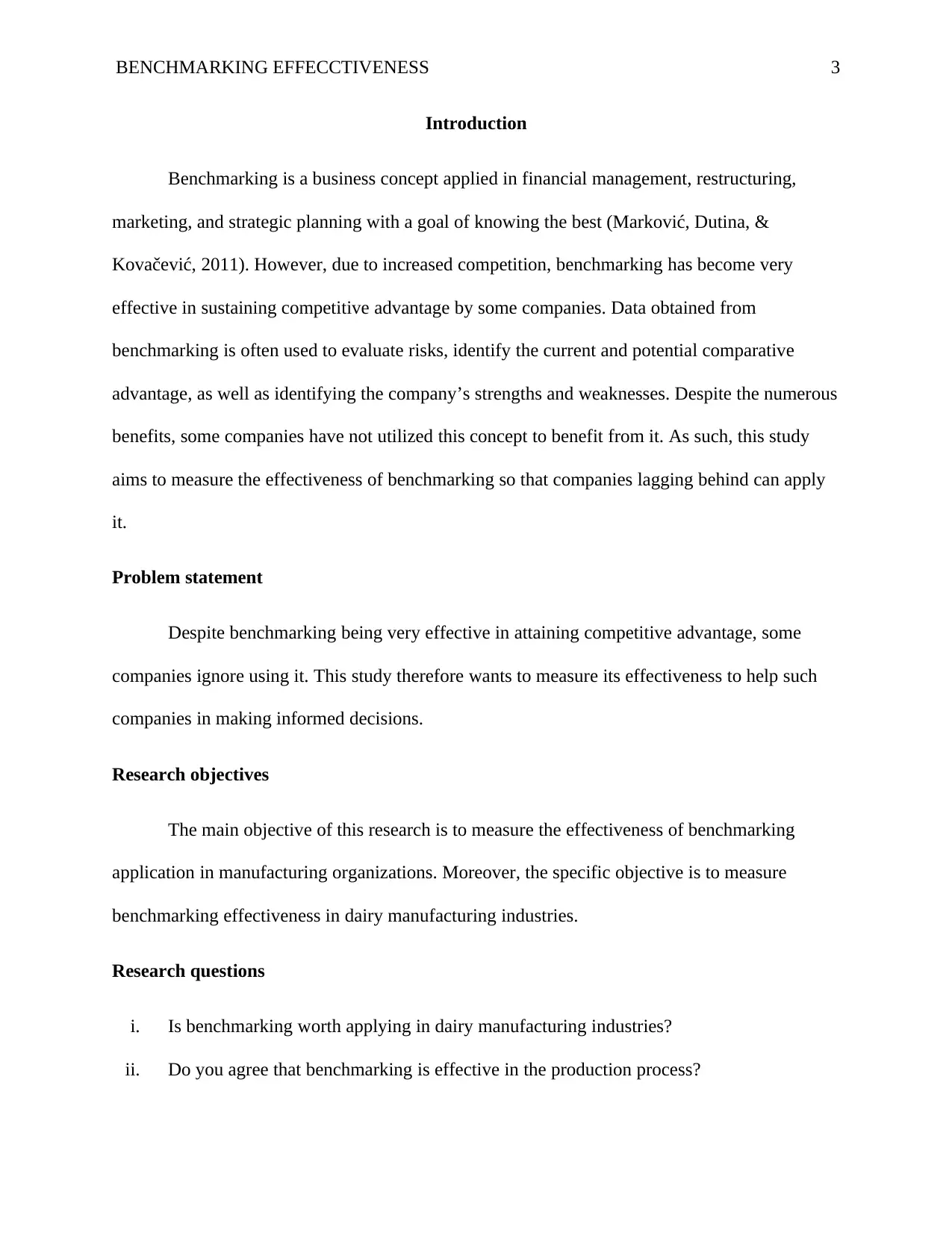
BENCHMARKING EFFECCTIVENESS 3
Introduction
Benchmarking is a business concept applied in financial management, restructuring,
marketing, and strategic planning with a goal of knowing the best (Marković, Dutina, &
Kovačević, 2011). However, due to increased competition, benchmarking has become very
effective in sustaining competitive advantage by some companies. Data obtained from
benchmarking is often used to evaluate risks, identify the current and potential comparative
advantage, as well as identifying the company’s strengths and weaknesses. Despite the numerous
benefits, some companies have not utilized this concept to benefit from it. As such, this study
aims to measure the effectiveness of benchmarking so that companies lagging behind can apply
it.
Problem statement
Despite benchmarking being very effective in attaining competitive advantage, some
companies ignore using it. This study therefore wants to measure its effectiveness to help such
companies in making informed decisions.
Research objectives
The main objective of this research is to measure the effectiveness of benchmarking
application in manufacturing organizations. Moreover, the specific objective is to measure
benchmarking effectiveness in dairy manufacturing industries.
Research questions
i. Is benchmarking worth applying in dairy manufacturing industries?
ii. Do you agree that benchmarking is effective in the production process?
Introduction
Benchmarking is a business concept applied in financial management, restructuring,
marketing, and strategic planning with a goal of knowing the best (Marković, Dutina, &
Kovačević, 2011). However, due to increased competition, benchmarking has become very
effective in sustaining competitive advantage by some companies. Data obtained from
benchmarking is often used to evaluate risks, identify the current and potential comparative
advantage, as well as identifying the company’s strengths and weaknesses. Despite the numerous
benefits, some companies have not utilized this concept to benefit from it. As such, this study
aims to measure the effectiveness of benchmarking so that companies lagging behind can apply
it.
Problem statement
Despite benchmarking being very effective in attaining competitive advantage, some
companies ignore using it. This study therefore wants to measure its effectiveness to help such
companies in making informed decisions.
Research objectives
The main objective of this research is to measure the effectiveness of benchmarking
application in manufacturing organizations. Moreover, the specific objective is to measure
benchmarking effectiveness in dairy manufacturing industries.
Research questions
i. Is benchmarking worth applying in dairy manufacturing industries?
ii. Do you agree that benchmarking is effective in the production process?
⊘ This is a preview!⊘
Do you want full access?
Subscribe today to unlock all pages.

Trusted by 1+ million students worldwide
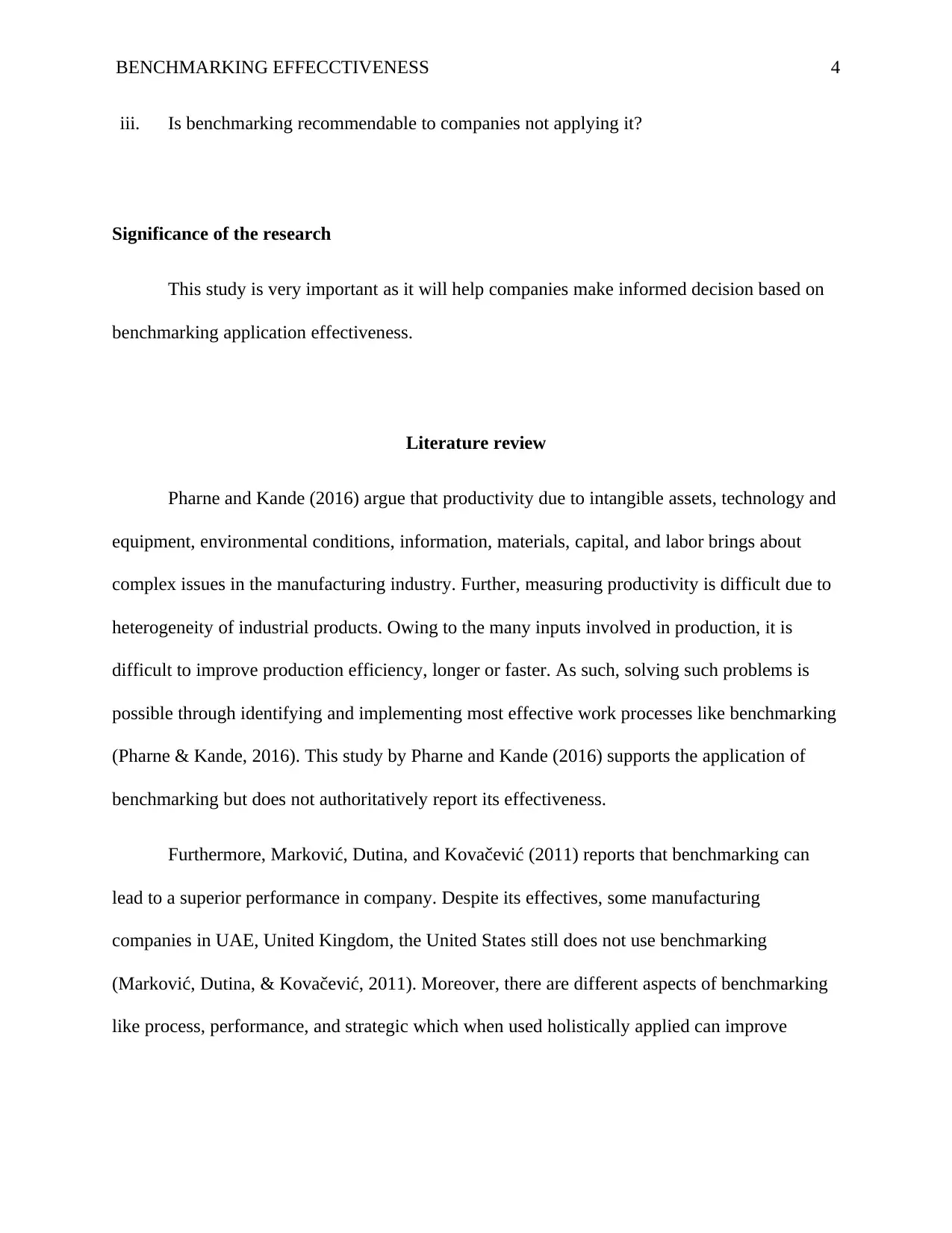
BENCHMARKING EFFECCTIVENESS 4
iii. Is benchmarking recommendable to companies not applying it?
Significance of the research
This study is very important as it will help companies make informed decision based on
benchmarking application effectiveness.
Literature review
Pharne and Kande (2016) argue that productivity due to intangible assets, technology and
equipment, environmental conditions, information, materials, capital, and labor brings about
complex issues in the manufacturing industry. Further, measuring productivity is difficult due to
heterogeneity of industrial products. Owing to the many inputs involved in production, it is
difficult to improve production efficiency, longer or faster. As such, solving such problems is
possible through identifying and implementing most effective work processes like benchmarking
(Pharne & Kande, 2016). This study by Pharne and Kande (2016) supports the application of
benchmarking but does not authoritatively report its effectiveness.
Furthermore, Marković, Dutina, and Kovačević (2011) reports that benchmarking can
lead to a superior performance in company. Despite its effectives, some manufacturing
companies in UAE, United Kingdom, the United States still does not use benchmarking
(Marković, Dutina, & Kovačević, 2011). Moreover, there are different aspects of benchmarking
like process, performance, and strategic which when used holistically applied can improve
iii. Is benchmarking recommendable to companies not applying it?
Significance of the research
This study is very important as it will help companies make informed decision based on
benchmarking application effectiveness.
Literature review
Pharne and Kande (2016) argue that productivity due to intangible assets, technology and
equipment, environmental conditions, information, materials, capital, and labor brings about
complex issues in the manufacturing industry. Further, measuring productivity is difficult due to
heterogeneity of industrial products. Owing to the many inputs involved in production, it is
difficult to improve production efficiency, longer or faster. As such, solving such problems is
possible through identifying and implementing most effective work processes like benchmarking
(Pharne & Kande, 2016). This study by Pharne and Kande (2016) supports the application of
benchmarking but does not authoritatively report its effectiveness.
Furthermore, Marković, Dutina, and Kovačević (2011) reports that benchmarking can
lead to a superior performance in company. Despite its effectives, some manufacturing
companies in UAE, United Kingdom, the United States still does not use benchmarking
(Marković, Dutina, & Kovačević, 2011). Moreover, there are different aspects of benchmarking
like process, performance, and strategic which when used holistically applied can improve
Paraphrase This Document
Need a fresh take? Get an instant paraphrase of this document with our AI Paraphraser
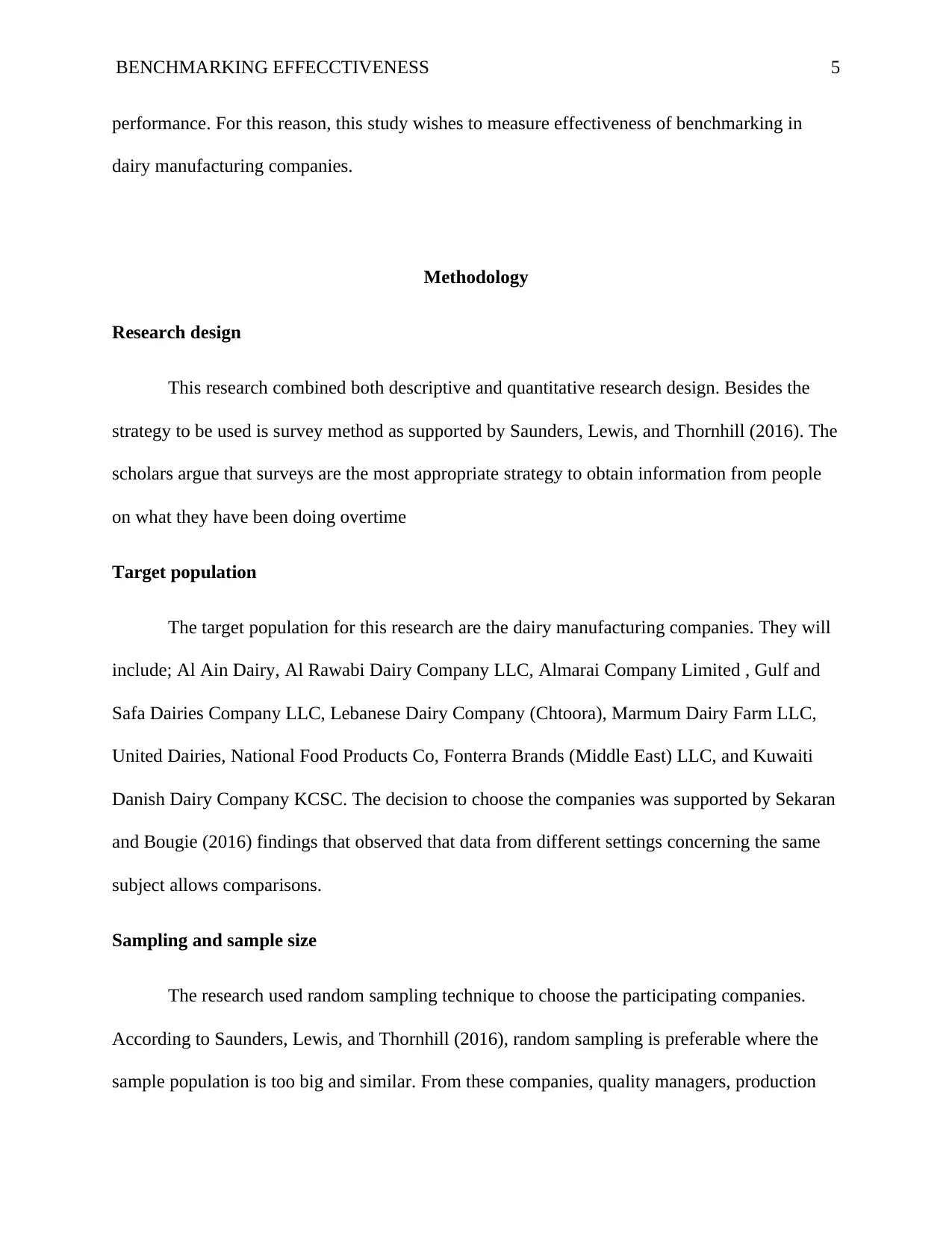
BENCHMARKING EFFECCTIVENESS 5
performance. For this reason, this study wishes to measure effectiveness of benchmarking in
dairy manufacturing companies.
Methodology
Research design
This research combined both descriptive and quantitative research design. Besides the
strategy to be used is survey method as supported by Saunders, Lewis, and Thornhill (2016). The
scholars argue that surveys are the most appropriate strategy to obtain information from people
on what they have been doing overtime
Target population
The target population for this research are the dairy manufacturing companies. They will
include; Al Ain Dairy, Al Rawabi Dairy Company LLC, Almarai Company Limited , Gulf and
Safa Dairies Company LLC, Lebanese Dairy Company (Chtoora), Marmum Dairy Farm LLC,
United Dairies, National Food Products Co, Fonterra Brands (Middle East) LLC, and Kuwaiti
Danish Dairy Company KCSC. The decision to choose the companies was supported by Sekaran
and Bougie (2016) findings that observed that data from different settings concerning the same
subject allows comparisons.
Sampling and sample size
The research used random sampling technique to choose the participating companies.
According to Saunders, Lewis, and Thornhill (2016), random sampling is preferable where the
sample population is too big and similar. From these companies, quality managers, production
performance. For this reason, this study wishes to measure effectiveness of benchmarking in
dairy manufacturing companies.
Methodology
Research design
This research combined both descriptive and quantitative research design. Besides the
strategy to be used is survey method as supported by Saunders, Lewis, and Thornhill (2016). The
scholars argue that surveys are the most appropriate strategy to obtain information from people
on what they have been doing overtime
Target population
The target population for this research are the dairy manufacturing companies. They will
include; Al Ain Dairy, Al Rawabi Dairy Company LLC, Almarai Company Limited , Gulf and
Safa Dairies Company LLC, Lebanese Dairy Company (Chtoora), Marmum Dairy Farm LLC,
United Dairies, National Food Products Co, Fonterra Brands (Middle East) LLC, and Kuwaiti
Danish Dairy Company KCSC. The decision to choose the companies was supported by Sekaran
and Bougie (2016) findings that observed that data from different settings concerning the same
subject allows comparisons.
Sampling and sample size
The research used random sampling technique to choose the participating companies.
According to Saunders, Lewis, and Thornhill (2016), random sampling is preferable where the
sample population is too big and similar. From these companies, quality managers, production
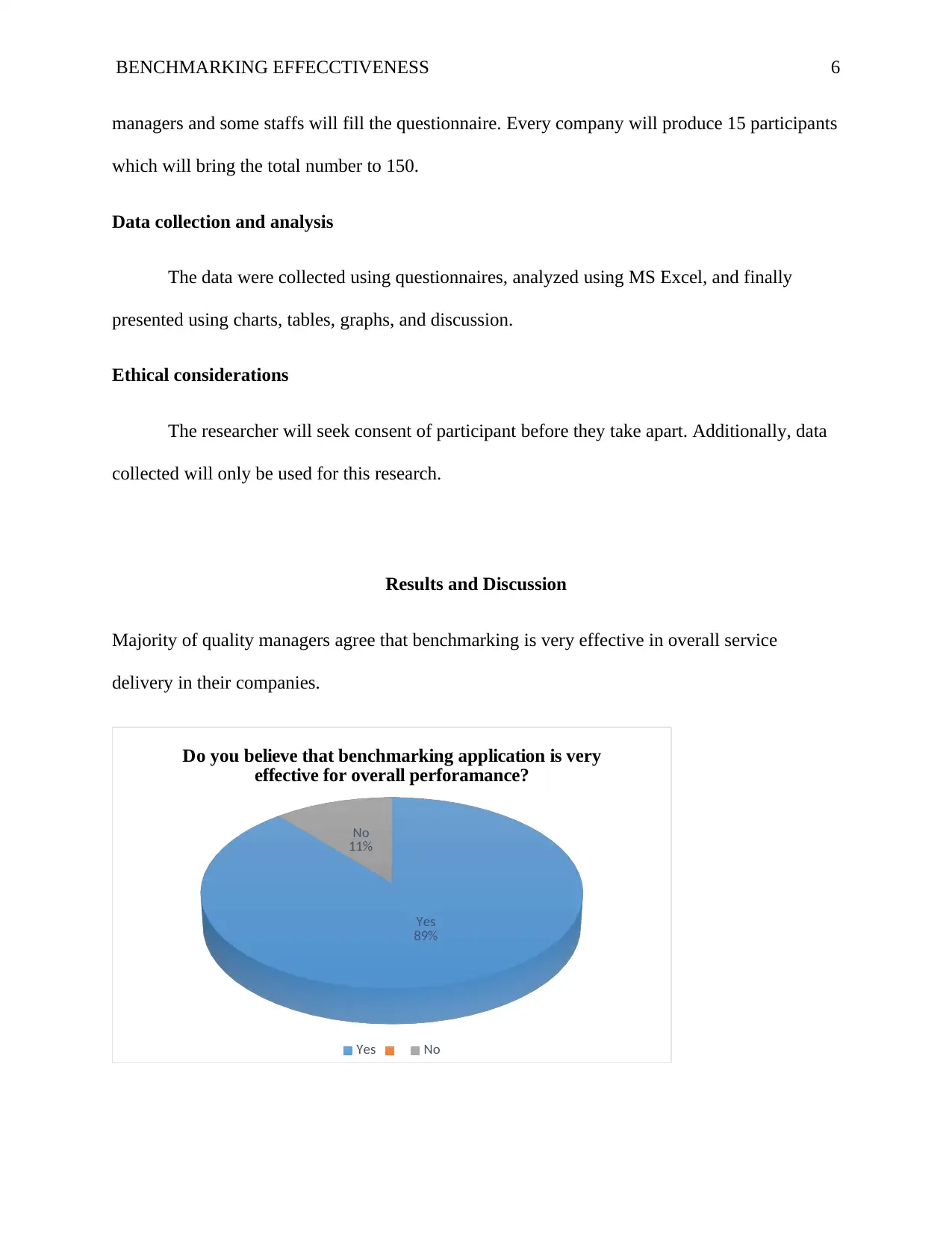
BENCHMARKING EFFECCTIVENESS 6
managers and some staffs will fill the questionnaire. Every company will produce 15 participants
which will bring the total number to 150.
Data collection and analysis
The data were collected using questionnaires, analyzed using MS Excel, and finally
presented using charts, tables, graphs, and discussion.
Ethical considerations
The researcher will seek consent of participant before they take apart. Additionally, data
collected will only be used for this research.
Results and Discussion
Majority of quality managers agree that benchmarking is very effective in overall service
delivery in their companies.
Yes
89%
No
11%
Do you believe that benchmarking application is very
effective for overall perforamance?
Yes No
managers and some staffs will fill the questionnaire. Every company will produce 15 participants
which will bring the total number to 150.
Data collection and analysis
The data were collected using questionnaires, analyzed using MS Excel, and finally
presented using charts, tables, graphs, and discussion.
Ethical considerations
The researcher will seek consent of participant before they take apart. Additionally, data
collected will only be used for this research.
Results and Discussion
Majority of quality managers agree that benchmarking is very effective in overall service
delivery in their companies.
Yes
89%
No
11%
Do you believe that benchmarking application is very
effective for overall perforamance?
Yes No
⊘ This is a preview!⊘
Do you want full access?
Subscribe today to unlock all pages.

Trusted by 1+ million students worldwide
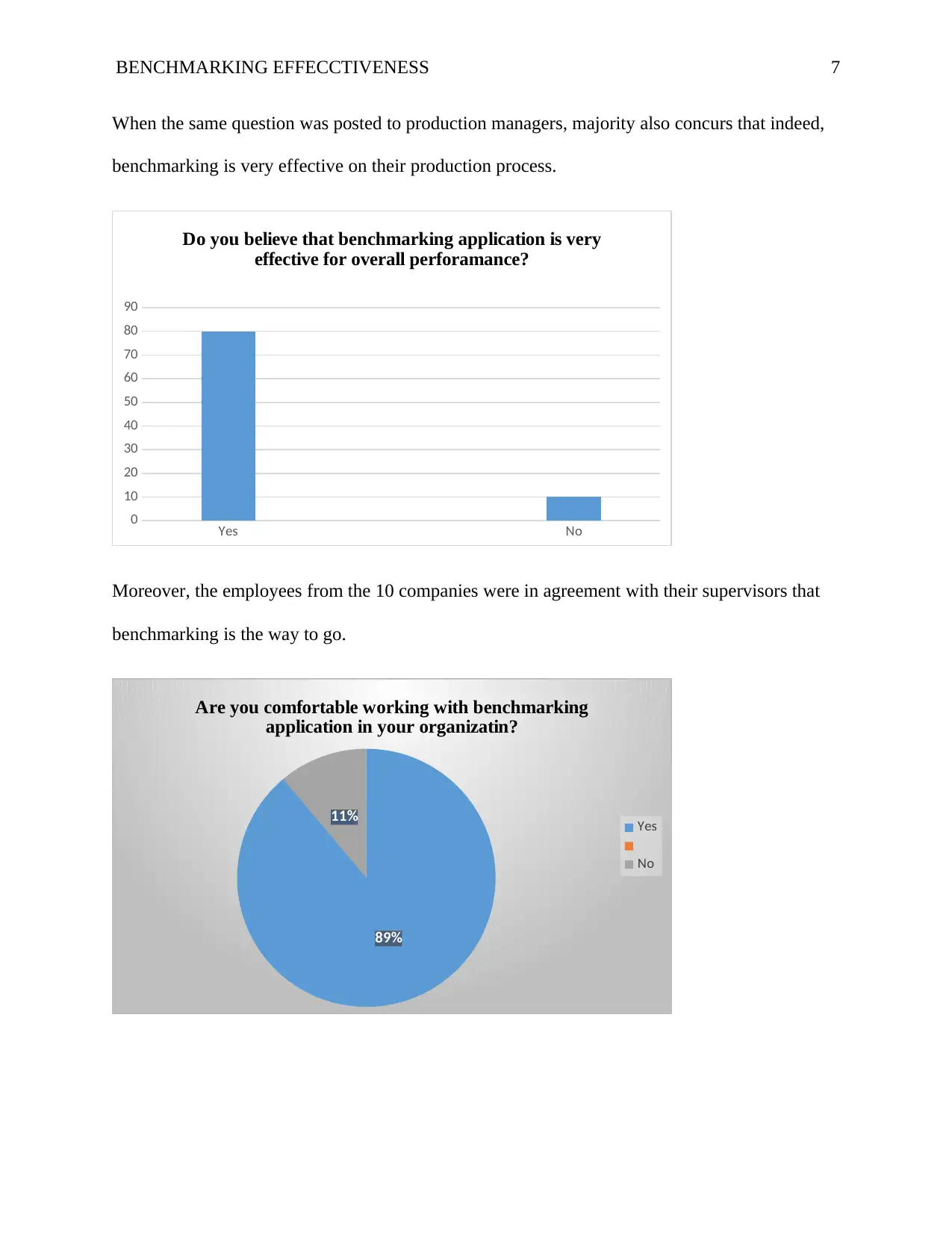
BENCHMARKING EFFECCTIVENESS 7
When the same question was posted to production managers, majority also concurs that indeed,
benchmarking is very effective on their production process.
Yes No
0
10
20
30
40
50
60
70
80
90
Do you believe that benchmarking application is very
effective for overall perforamance?
Moreover, the employees from the 10 companies were in agreement with their supervisors that
benchmarking is the way to go.
89%
11%
Are you comfortable working with benchmarking
application in your organizatin?
Yes
No
When the same question was posted to production managers, majority also concurs that indeed,
benchmarking is very effective on their production process.
Yes No
0
10
20
30
40
50
60
70
80
90
Do you believe that benchmarking application is very
effective for overall perforamance?
Moreover, the employees from the 10 companies were in agreement with their supervisors that
benchmarking is the way to go.
89%
11%
Are you comfortable working with benchmarking
application in your organizatin?
Yes
No
Paraphrase This Document
Need a fresh take? Get an instant paraphrase of this document with our AI Paraphraser
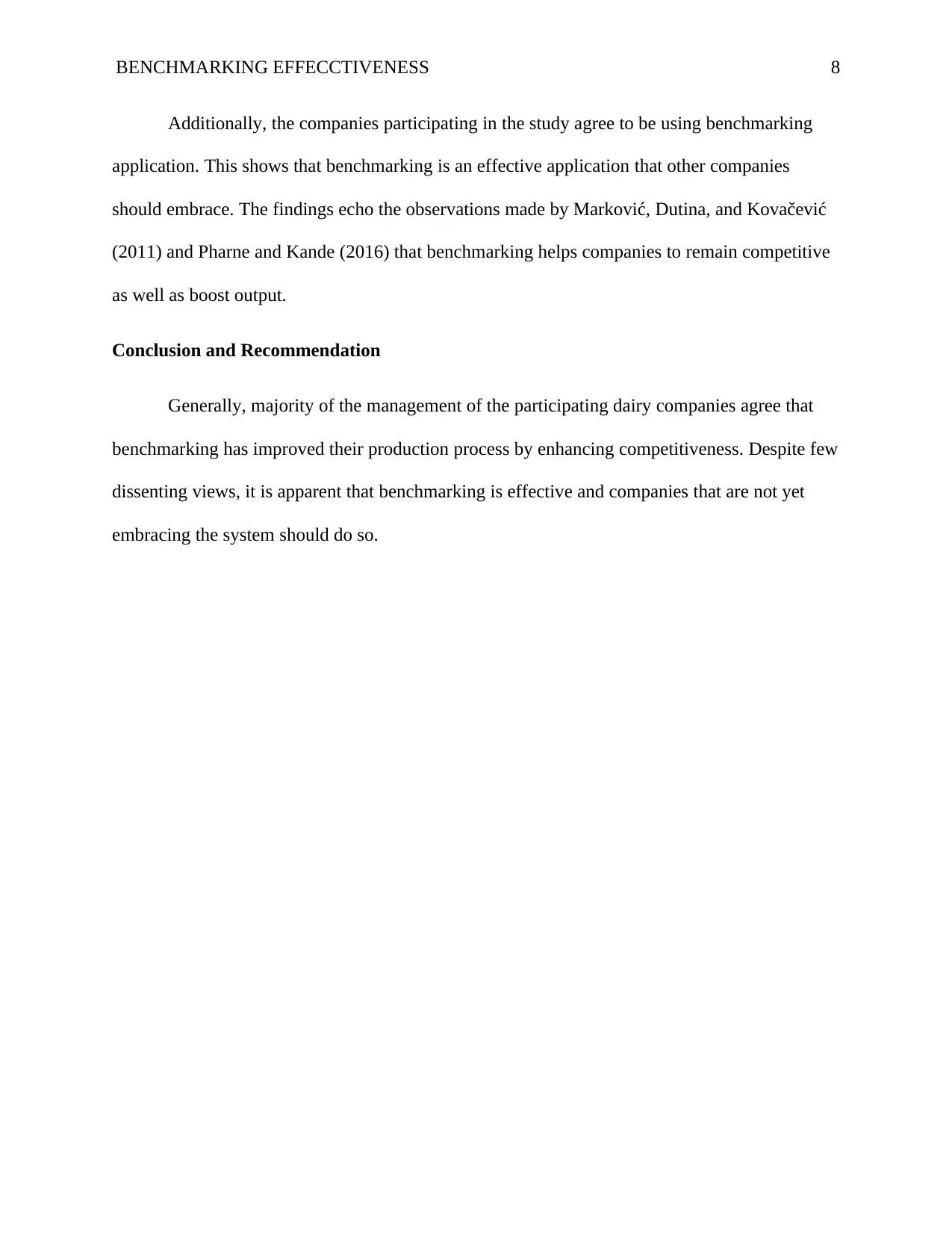
BENCHMARKING EFFECCTIVENESS 8
Additionally, the companies participating in the study agree to be using benchmarking
application. This shows that benchmarking is an effective application that other companies
should embrace. The findings echo the observations made by Marković, Dutina, and Kovačević
(2011) and Pharne and Kande (2016) that benchmarking helps companies to remain competitive
as well as boost output.
Conclusion and Recommendation
Generally, majority of the management of the participating dairy companies agree that
benchmarking has improved their production process by enhancing competitiveness. Despite few
dissenting views, it is apparent that benchmarking is effective and companies that are not yet
embracing the system should do so.
Additionally, the companies participating in the study agree to be using benchmarking
application. This shows that benchmarking is an effective application that other companies
should embrace. The findings echo the observations made by Marković, Dutina, and Kovačević
(2011) and Pharne and Kande (2016) that benchmarking helps companies to remain competitive
as well as boost output.
Conclusion and Recommendation
Generally, majority of the management of the participating dairy companies agree that
benchmarking has improved their production process by enhancing competitiveness. Despite few
dissenting views, it is apparent that benchmarking is effective and companies that are not yet
embracing the system should do so.
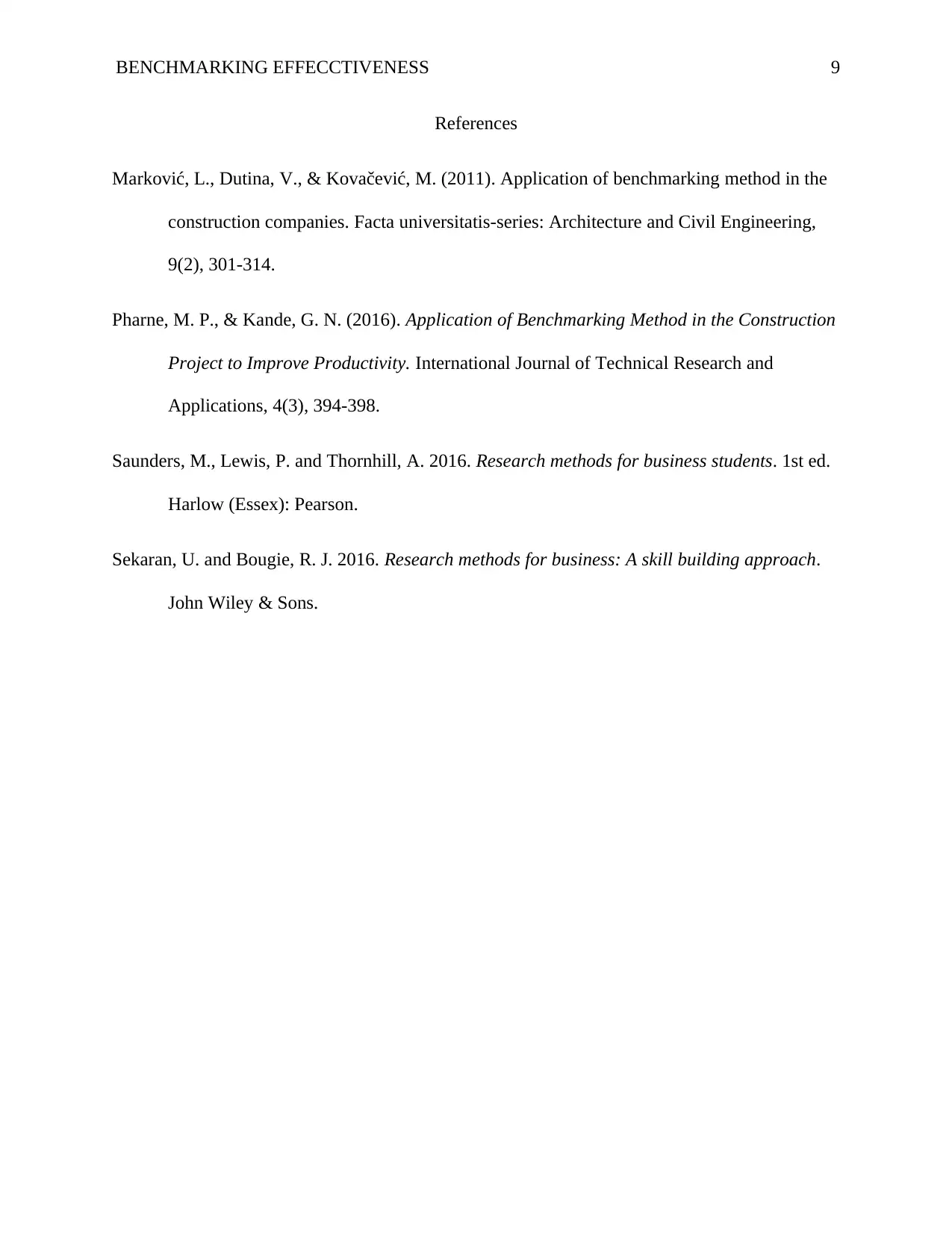
BENCHMARKING EFFECCTIVENESS 9
References
Marković, L., Dutina, V., & Kovačević, M. (2011). Application of benchmarking method in the
construction companies. Facta universitatis-series: Architecture and Civil Engineering,
9(2), 301-314.
Pharne, M. P., & Kande, G. N. (2016). Application of Benchmarking Method in the Construction
Project to Improve Productivity. International Journal of Technical Research and
Applications, 4(3), 394-398.
Saunders, M., Lewis, P. and Thornhill, A. 2016. Research methods for business students. 1st ed.
Harlow (Essex): Pearson.
Sekaran, U. and Bougie, R. J. 2016. Research methods for business: A skill building approach.
John Wiley & Sons.
References
Marković, L., Dutina, V., & Kovačević, M. (2011). Application of benchmarking method in the
construction companies. Facta universitatis-series: Architecture and Civil Engineering,
9(2), 301-314.
Pharne, M. P., & Kande, G. N. (2016). Application of Benchmarking Method in the Construction
Project to Improve Productivity. International Journal of Technical Research and
Applications, 4(3), 394-398.
Saunders, M., Lewis, P. and Thornhill, A. 2016. Research methods for business students. 1st ed.
Harlow (Essex): Pearson.
Sekaran, U. and Bougie, R. J. 2016. Research methods for business: A skill building approach.
John Wiley & Sons.
⊘ This is a preview!⊘
Do you want full access?
Subscribe today to unlock all pages.

Trusted by 1+ million students worldwide
1 out of 9
Related Documents
Your All-in-One AI-Powered Toolkit for Academic Success.
+13062052269
info@desklib.com
Available 24*7 on WhatsApp / Email
![[object Object]](/_next/static/media/star-bottom.7253800d.svg)
Unlock your academic potential
Copyright © 2020–2025 A2Z Services. All Rights Reserved. Developed and managed by ZUCOL.




